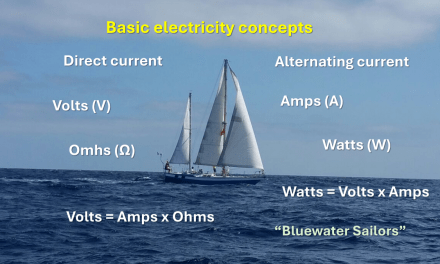Introduction.
An ocean-going sailboat requires a reliable, robust, and safe electrical system, prepared for the marine environment with its increased salinity and humidity, and that provides sufficient power to power all the boat’s equipment.
Typically, a sailboat will have a 12-volt (or alternatively, 24-volt) direct current (DC) electrical circuit, with a battery dedicated exclusively to starting the boat’s engine (similar to a car’s starter), and at least one service battery used to power the rest of the boat’s equipment (lights, refrigerator, navigation and communications equipment, autopilot, etc.).
These 12-volt (or 24-volt) engine and service batteries can be charged onboard the sailboat with the engine’s alternator, solar panels, or various types of generators (the most common being diesel, wind, or hydrogen).
To be able to use AC power (220V AC) equipment on board a sailboat, if I’m docked in port, I’ll connect the boat to shore power (220V AC); while if I’m sailing, I’ll need an inverter (to transform the 12V DC from the batteries into 220V AC) or a diesel generator.
Having a powerful portable power station, such as the BLUETTI, on a sailboat can complement our electrical system and facilitate the convenient and simultaneous use of multiple 5V, 12V, and 220V devices in any situation.
We installed a BLUETTI AC 180 device on board the ocean-going sailboat “Prince Azur” and, as a challenge, tested it during a multi-day voyage. Below, we’ll look at the main features of this device, how we installed it on board the sailboat, the charging methods, and how we used it on the sailboat. to conclude with a final assessment of this challenge.
The chapter includes a video description of the installation and use on board the sailboat, which you can watch below:
General features of the BLUETTI AC 180
The BLUETTI AC180 is a powerful and versatile portable power station that integrates an 1800W pure sine wave inverter with a 1152Wh lithium (LiFePO4) battery, a control screen, and various internal electronic devices to adjust the charging and discharging of the equipment.
The BLUETTI AC180 has two alternating current (AC) output ports with an output of 1,800W (up to 2,700W in Power Lifting mode), five USB ports (four USB-A and one USB-C), a 12V/10A cigarette lighter socket, and a wireless charger for compatible mobile devices. This means it offers a wide range of uses for all types of electrical and electronic equipment on our sailboat.
When it comes to recharging the BLUETTI AC180, it also offers many possibilities. It supports alternating current (AC) input power of up to 1440W and direct current (DC) input power of up to 500W, allowing it to be fully charged in just a few hours, or progressively throughout the day.
In addition, you can monitor the equipment visually with the integrated display or with the BLUETTI app with Bluetooth connectivity, which allows you to monitor the equipment’s status onboard with a mobile phone from anywhere on the boat and optimize charging and power consumption according to your needs.
Installation on board a sailboat.
The marine environment is highly saline and humid, and the deck of a sailboat is highly exposed to spray and inclement weather, rolling, and pitching, especially in rough seas. Therefore, it is preferable to choose a well-protected location inside the sailboat to install the BLUETTI.
The boat’s saloon is usually a good place; it is located amidships and is where much of the onboard life normally takes place. It is also the location we have chosen for the BLUETTI AC 180. Air circulation must be provided on both sides of the equipment to facilitate cooling.
Near the BLUETTI, we will place the AC (220V) and DC (12V cigarette lighter type) power outlets, as well as the solar panels, to charge the equipment in the most convenient way, depending on the sailing situation.
As a safety measure, it is very important to connect the “GROUNDING” output to the sailboat’s ground. In the case of a metal-hulled sailboat like the “Prince Azur,” we will connect the GROUNDING to the boat’s hull.
Furthermore, since in rough seas the sailboat can roll and pitch excessively, or even capsize, the BLUETTI must be securely fastened and lashed to prevent damage to the equipment or damage.
Using BLUETTI on board a sailboat.Este contenido solo está disponible para subscriptores de navegantesoceanicos.com
Efecúe Log In para desbloquear.
Este contenido solo está disponible para subscriptores de navegantesoceanicos.com
Efecúe Log In para desbloquear.
Links of interes:





